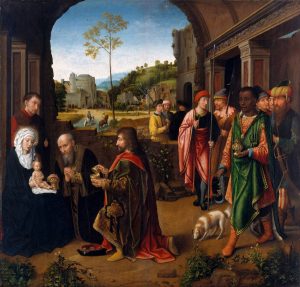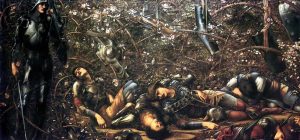Jean Carlos Pichardo
Professor Trofimova
History of Graphic Design
April 18, 2018
There were events in history that created outstanding pieces of illumination, lasting for centuries. During those events, many artists, such as Gerard David and Edward Burne-Jones, were born. Gerard David was in the movement of Illuminated Manuscripts while Edward Burne-Jones was in the Arts and Crafts Movement. Two completely different time periods. To this day, the concept and style still continues in modern society.
Gerard David was born in the mid-1400s located in Utrecht. During that time, the Early Netherlandish painting movement raised, which gave him the opportunity to become a well-known painter and manuscript illuminator. It was also the movement of the earliest illuminated manuscript during that time. Those movements consider the usage of color, detail décor and styling. All these decorative books and paintings were written and painted by hand. Gerard David was known as a brilliant painter and manuscript illuminator. He was also known for the use of colors on his works. He spent his career in Bruges, where he became the leading painter of Bruges. David also became dean of the Guild of Saint Luke. His works mostly consist of religious scenes. One of his works is called The Adoration of the Magi.
Gerard David created the Adoration of the Magi during the 1500s. The painting is a demonstrating a religious event of magi’s visiting the chosen god. The title of the piece is showing the love and joy of visiting the child of god. The Adoration of the Magi has lots of details in the clothing and environment, especially the brilliant use of colors. You can see in the far distance of amount of detail put into by the trees, the people, and the details on the buildings.
Edward Burne-Jones was born in August 28, 1833 living in Birmingham, England. He became a known British artist and designer during the Arts and Crafts Movement. The Arts and Crafts Movement was a movement for artists and designers to created hand crafted pieces than industrial machinery. They value the craftsmanship of handmade pieces by the quality than the quantity of mass-production. However, there were issues when it comes to the Arts and Crafts Movement with their pieces. Jones was one of the many creators of the Arts and Craft Movement by his decorative paintings and crafts. During his earlier years, he created stained glasses on many churches and universities. Jones also created many paintings using oil as the main tool. Many of his paintings resemble events of historic events. One of his many works is called The Briar Wood.
Edward Burne-Jones created the Briar Wood around 1890s. The art piece illustrates soldiers lying on the ground surrounded by thorns except for one. The soldiers are sleeping on the ground while one is watching over them while their weapons and shields are tangled up in the thorn bush. The imagery is well done by the amount of details on their armor, the thorn bush, and the color of the mood. At first, it seems they are dead or attacked by one soldier but you can actually see there’s no blood or any sign of an attack. This really helps to describe the scenery of this piece.
Both of these paintings have many similarities among them but there are some differences in the style itself. For one, both artists had great use of color and realism in the paintings. Gerard David used traditionally technique on his work due to his timeline with oil and wood canvas. However, Edward Burne-Jones used photogravure for his work, which is the use of a metal place and etching on the canvas to print the image. Regardless of their technique and time era, you can see the amount of details spent by both artists. As mention earlier, the background of The Adoration of the Magi has realistic detail by the clothing on the people and the windows and doors on the buildings. On The Briar Wood, the imagery has details on the thorn bush and the armor on the soldiers. Both have a sense of mood by the use of colors and scenery about the artist.
Gerard David – The Adoration of the Magi
Edward Burne-Jones – The Briar Wood





